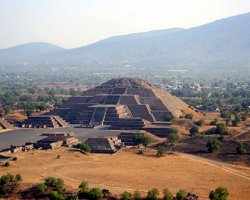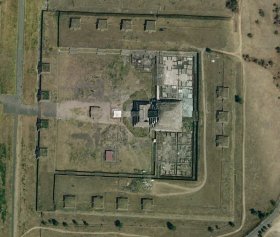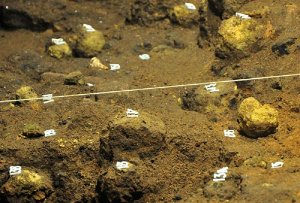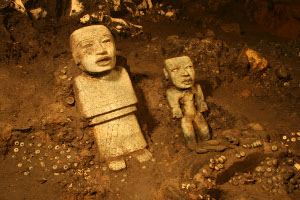
Teotihuacán is a large archaeological site in Mexico (North America) which is covering more than 20 square kilometers. Only about 3 percent of the site has been fully excavated. During the 14th century, before the Spanish conquest, the site had been found by the Aztec people who were traveling south. It was completely abandoned. It's original builders are still unknown, but the Aztecs were certain only the gods could have made it. Therefore they called it: "Teotihuacán", and they regarded it as a holy place.
 In
the Nathuatl language of the
Aztecs, "Teotihuacán" could translate to something like: "place where
gods were born" or "place of the origin of gods". Indigenous legends
assert that it was the "birthplace of creation", where the gods would
observe the evolving world and judge its progress. The two largest
pyramids would been built by the "giants" that existed in those days,
and the purpose of the site was to "transform men into gods",
probably meant allegorical. This could mean that this place was
once a place for spiritual initiations, just like the Great Pyramid in
Giza - according to the ancient Egyptian esoteric knowledge. (Image
right: Pyramid of the Moon.)
In
the Nathuatl language of the
Aztecs, "Teotihuacán" could translate to something like: "place where
gods were born" or "place of the origin of gods". Indigenous legends
assert that it was the "birthplace of creation", where the gods would
observe the evolving world and judge its progress. The two largest
pyramids would been built by the "giants" that existed in those days,
and the purpose of the site was to "transform men into gods",
probably meant allegorical. This could mean that this place was
once a place for spiritual initiations, just like the Great Pyramid in
Giza - according to the ancient Egyptian esoteric knowledge. (Image
right: Pyramid of the Moon.)
 Until
today, no
single burial had
been found within or below the pyramids, so they were most probably not
tombs. Academics agree that the city was built for spiritual and
political purposes. Although the structures on the site were - like the
pyramids of Giza - obviously built with stability and durability in
mind, they were actually not built with large megalithic stones, but
smaller ones. There are estimated to be over 600 structures including
two large pyramids; the Pyramid of the Sun and the Pyramid of the Moon,
approximately 70 other large structures, and like over 500 much smaller
ones.
Until
today, no
single burial had
been found within or below the pyramids, so they were most probably not
tombs. Academics agree that the city was built for spiritual and
political purposes. Although the structures on the site were - like the
pyramids of Giza - obviously built with stability and durability in
mind, they were actually not built with large megalithic stones, but
smaller ones. There are estimated to be over 600 structures including
two large pyramids; the Pyramid of the Sun and the Pyramid of the Moon,
approximately 70 other large structures, and like over 500 much smaller
ones.
Among these smaller structures, there are elevated
square platforms, neatly arranged as seen in the image on the left,
taken from above the Pyramid
of the Moon. (Click here for a larger
image.) According to Shirley Andrews' book "Atlantis: Insights
from a Lost Civilization" (2002), the building plan and
orientation of the buildings at Teotihuacán were built in alignment
to the rising and setting of the Pleiades.
In the year
2003, a tunnel was discovered below the Temple of the Feathered
Serpent (the third largest pyramid of Teotihuacan and known as the
oldest pyramid in Mexico) when a heavy rainstorm exposed a shaft that
led to a spot about halfway down its length. Over the next decade the
team of archaeologist Sergio Gómez dug out the tunnel and found a
series of two chambers on either side of the tunnel (north and south)
in 2013. During the next years, many discoveries were being made. They
found
large spiral seashells, cat bones, pottery, fragments of human skin,
wooden masks covered with inlaid rock jade and quartz, elaborate
necklaces, rings, beetle wings arranged in a box, sculptures of
jaguars, greenstone crocodile teeth, and pyrite mirrors.

With the aid of a small robot
equipped with camera and infra-red scanners, Sergio's
team also found hundreds of small spheres (dubbed "disco balls" by
the archaeologists). Ranging from 4 to 13 centimeters, the balls have
a core of clay and are covered with yellow jarosite formed by the
oxidation of pyrite (Fool's Gold). The purpose of these
orbs is still unknown, although they are considered to have been used
in ritual practices. (See image right. Photo credit: INAH, National
Institute of Anthropology and History.)
In her book: "Convoluted Universe (2001)", regression hypnotherapist
Dolores Cannon described the finding of crystal balls of various sizes
in the jungles of Central America, that "glow at night and produce light, but not
as clearly as they used to".
The book tells us that most of us would have only heard of the large
ones (the
Costa Rica stone spheres?) but they have found smaller ones about the
size of a bowling ball or slightly smaller. "Archaeologists
are calling them stone because they appear to be stone, but they are a
specialized type of crystal... They are referred to as crystals because
of their molecular structure."
They were already used during the times of Atlantis as interior lights,
street lights, and spot lights, to see in the dark, and then there were
also used other
types of crystals for other purposes, like crystals that radiated heat
to help warm houses. According some news articles, these
spheres that had been found below the Temple of the Feathered Serpent
would appear to be "glowing" in the dark, so perhaps these were such
kind of spheres as mentioned in this book and used for lighting.

Beyond these chambers, even more chambers were discovered with more
objects, including: a wooden box filled with seashells
that were carved with stone tools, rubber balls, jaguar remains, four
greenstone human statues, a lot of beads and crystals shaped into eyes
(the eyes of the figures that had came off). (Image left: 2 of the
statues,
beads and possibly one green crystal eye. Credit: Fine Arts Museums of
San Francisco. Click here for a larger
image.)
There also was the discovery of a miniature mountainous landscape with tiny pools of liquid mercury representing lakes. The walls and ceiling of the tunnel were found to have been impregnated with mineral powder composed of magnetite, pyrite and hematite, providing a certain brightness to the place. (Which may add further evidence that the spheres could have been used as light sources.) Earlier before this discovery, mercury had also been found at three other sites in Central America; two of the Mayans and one of the Olmecs. (Source: Wikipedia.)



